Making summer sausage at home is something that I have been doing for many years. This sausage is very flavorful and not too fatty. Smoked summer sausage, the way it has been done traditionally, is to die for. Smoke greatly enhances flavor and increases shelf life of sausage due to it's antibacterial properties. In this article I will talk about how to make summer sausage at home and share my experience.
What is summer sausage?
Summer sausage is an American semi-dry fermented sausage typically made of pork and beef. Summer sausage made of beef alone is also common. In the past this sausage was made during winter time to be eaten during summer when working in the field. This is how the name 'summer sausage' came to be. Properly made summer sausage can be stored without refrigeration for a very long time. Hence, it is often used as a component of food gift baskets along with cheeses and jams.
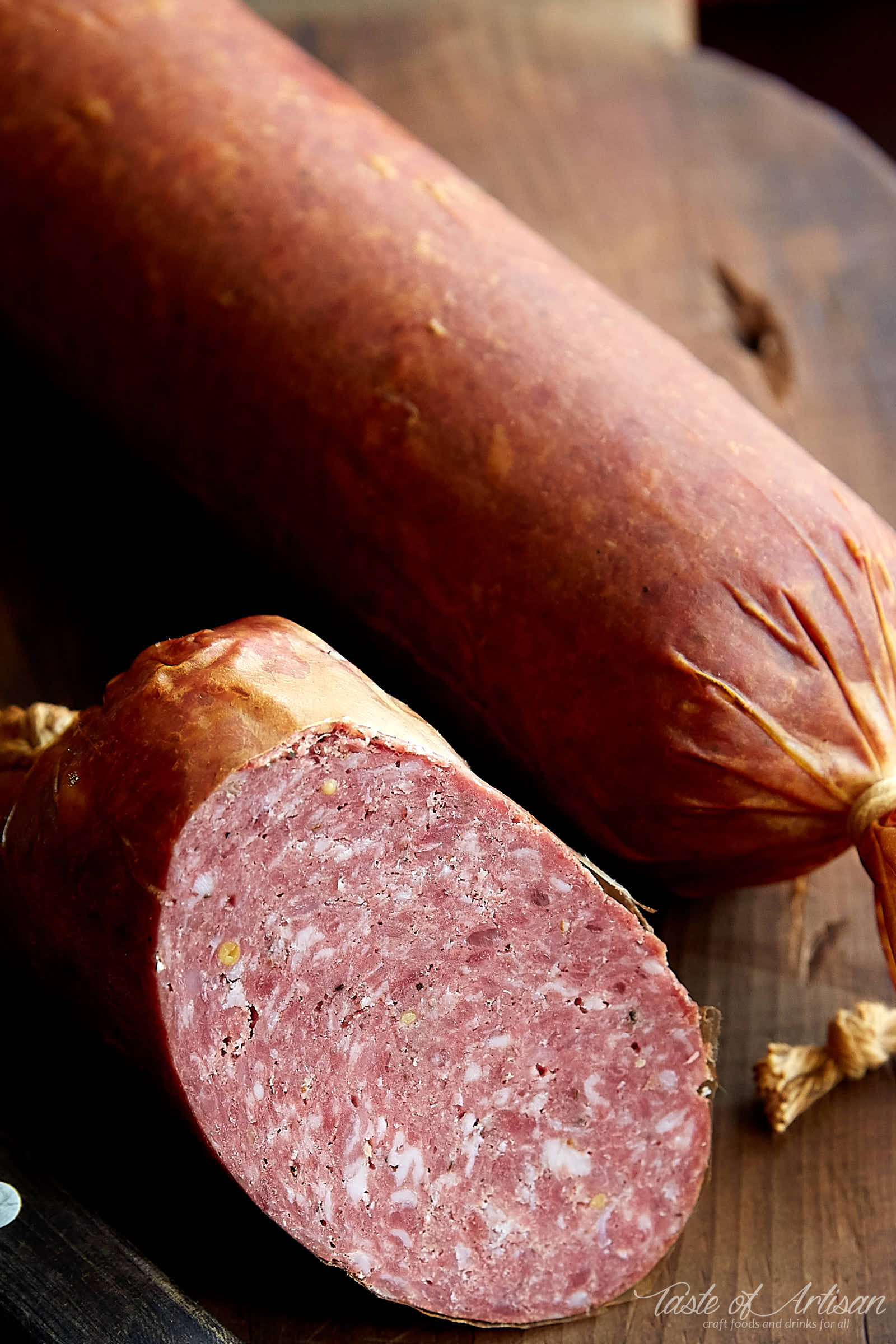
The meat
Summer sausage is typically made of beef and pork, or beef alone. Some recipes make use of beef hearts as well. The ratios of beef to pork vary from 75% beef and 25% pork to 25% beef and 75% pork. It really depends on personal preference. I like more beefy flavor and prefer a 2/3 beef to 1/3 pork ratio.
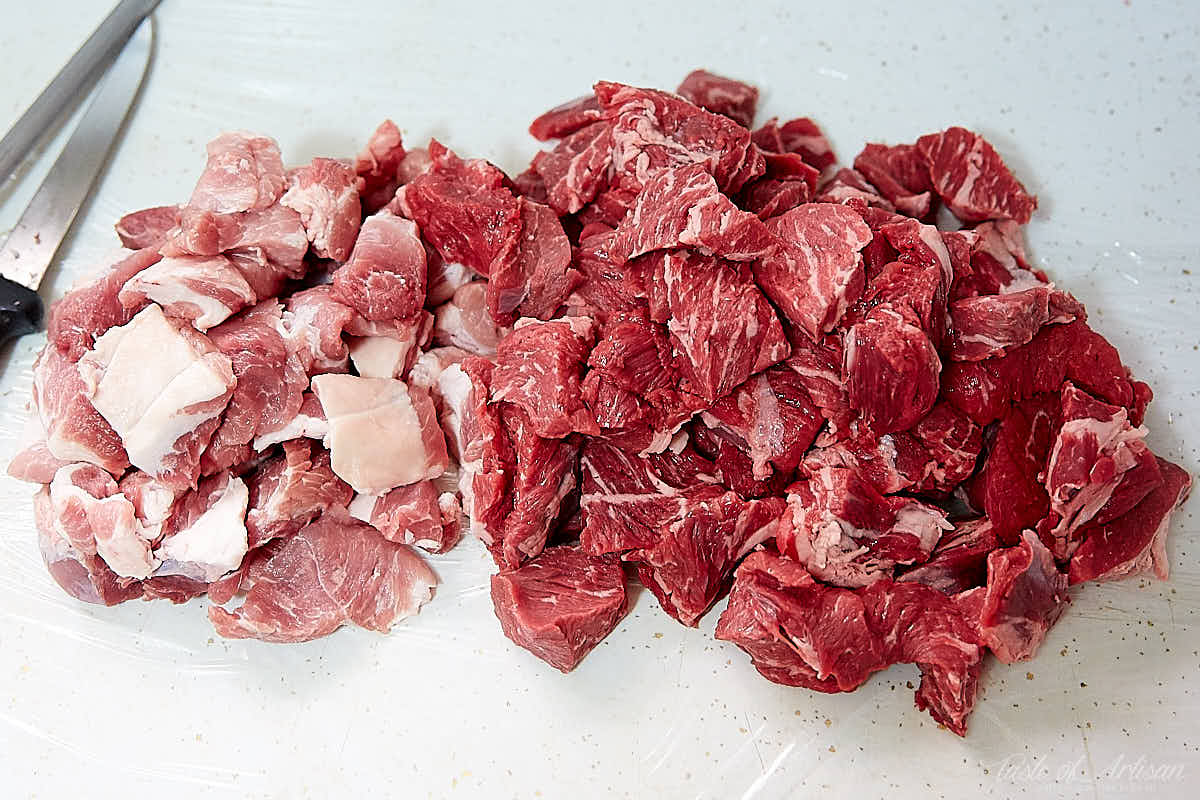
The taste of summer sausage is very much dependent on freshness and quality of meat. Beef chuck is a very flavorful cut and is commonly used for making summer sausage. Butt is a very good choice for the pork cut. To get the best results, buy your meat fresh and grind it yourself. Alternatively, ask your butcher to grind it for you. You want to grind the meat fairly fine, through a 3/16" (4.5mm) plate.
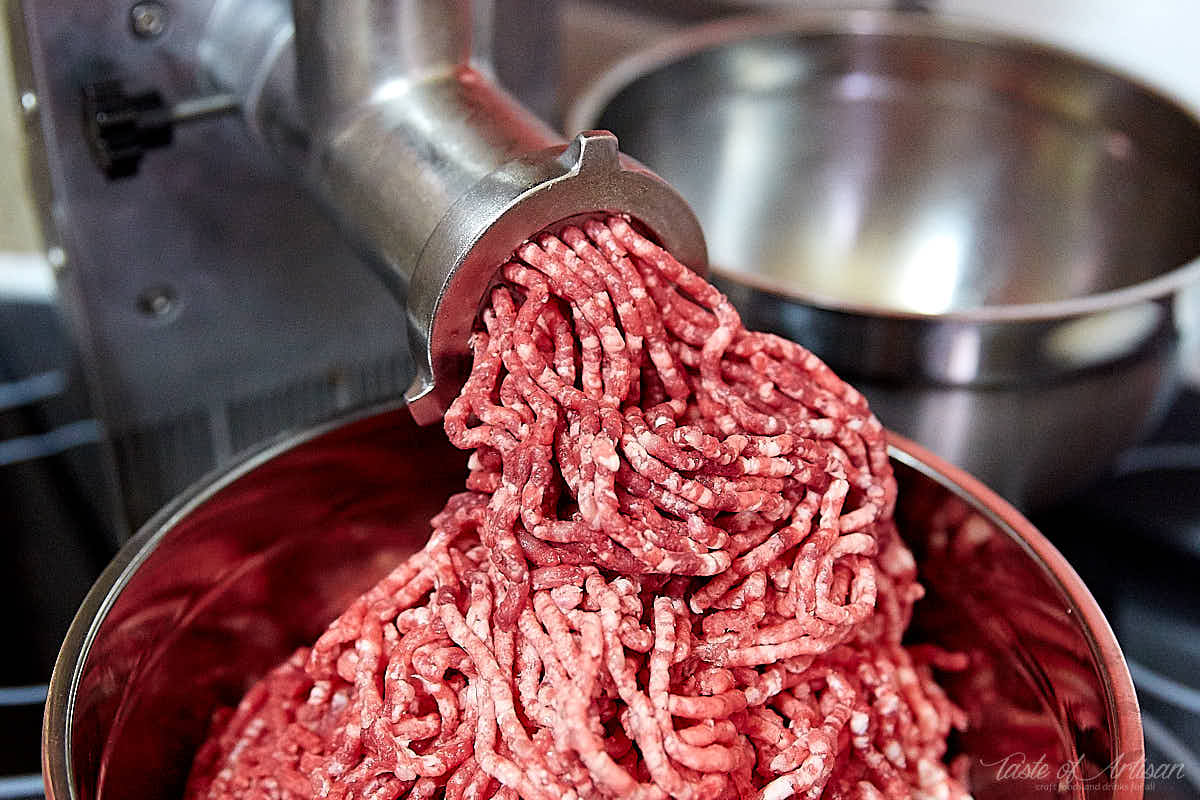
Summer sausage spices
You will find mustard seed, black pepper and garlic among the most commonly used spices in summer sausage. Many recipes also use coriander, allspice, ginger and other spices. The best summer sausage is the sausage made to your taste, so feel free to experiment with you favorite spices. If possible, grind your spices just before adding them to the ground meat. This will help you get the most flavor out of them.
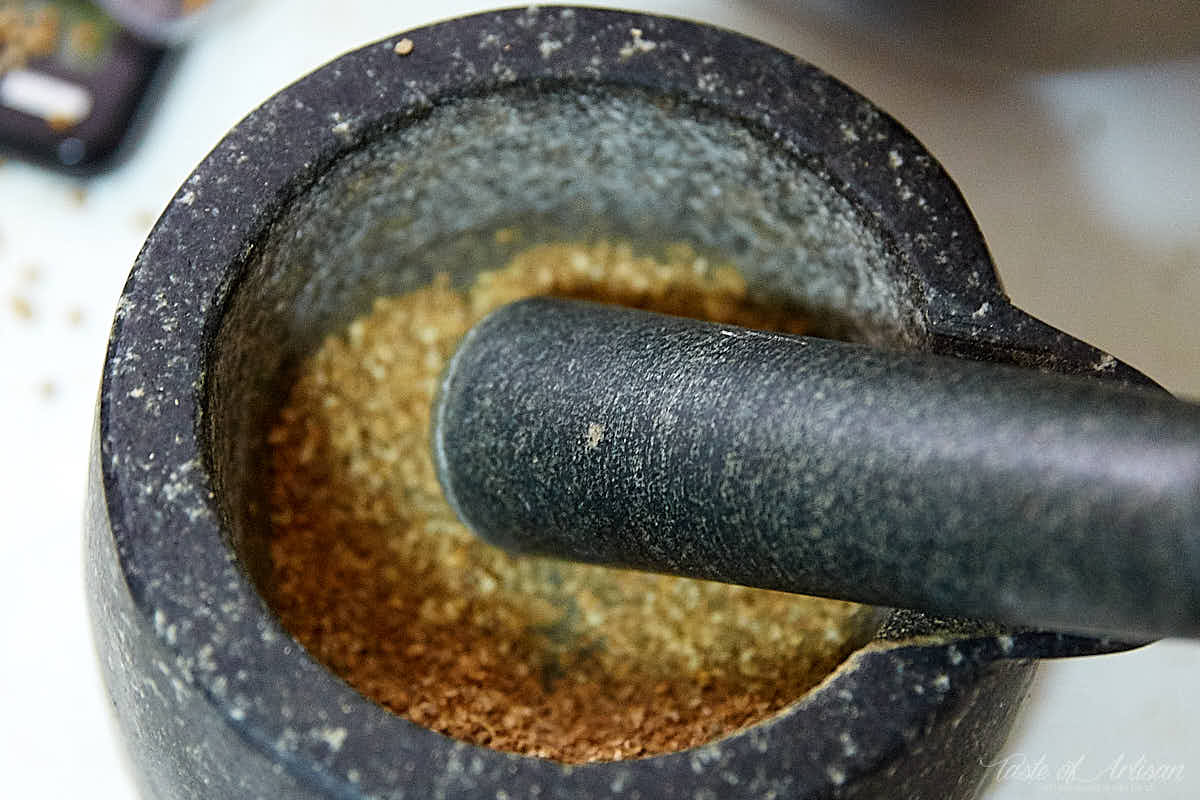
Curing salt and cultures
As summer sausage is a fermented sausage, a meat culture such as FL-C is used. Bactoferm F-LC meat culture with bio protective properties is used for production of fermented sausages with short or traditional production times. F-LC is recommended for the production of all types of fermented sausages and is known for suppressing growth of Listeria. During fermentation pH of the meat drops to 5.3 which helps inhibit growth of pathogenic bacteria and gives the sausage its tangy taste. FL-C culture can be purchased from the sausagemaker.com or butcher-packer.com.
Summer sausage is fermented and then smoked for hours at temperatures that promote growth of unwanted bacteria. To prevent that, Cure #1 (also known as pink salt) is used. Pink salt also improves flavor, prevents food poisoning, tenderizes meat, and develops the pink color widely known and associated with smoked meats. You can purchase Cure #1 from the online stores mentioned above as well as Amazon: DQ Curing Salt #1 / Pink Salt.
Mixing meat and spices
You want to make sure that the salt and the spices are mixed well with the meat and distributed evenly. One way to ensure even distribution is to mix the seasonings with the pieces of meat before they are ground. I use this method very frequently with great results. Mix the meat until it becomes sticky and keeps together. At this point it is ready for stuffing.
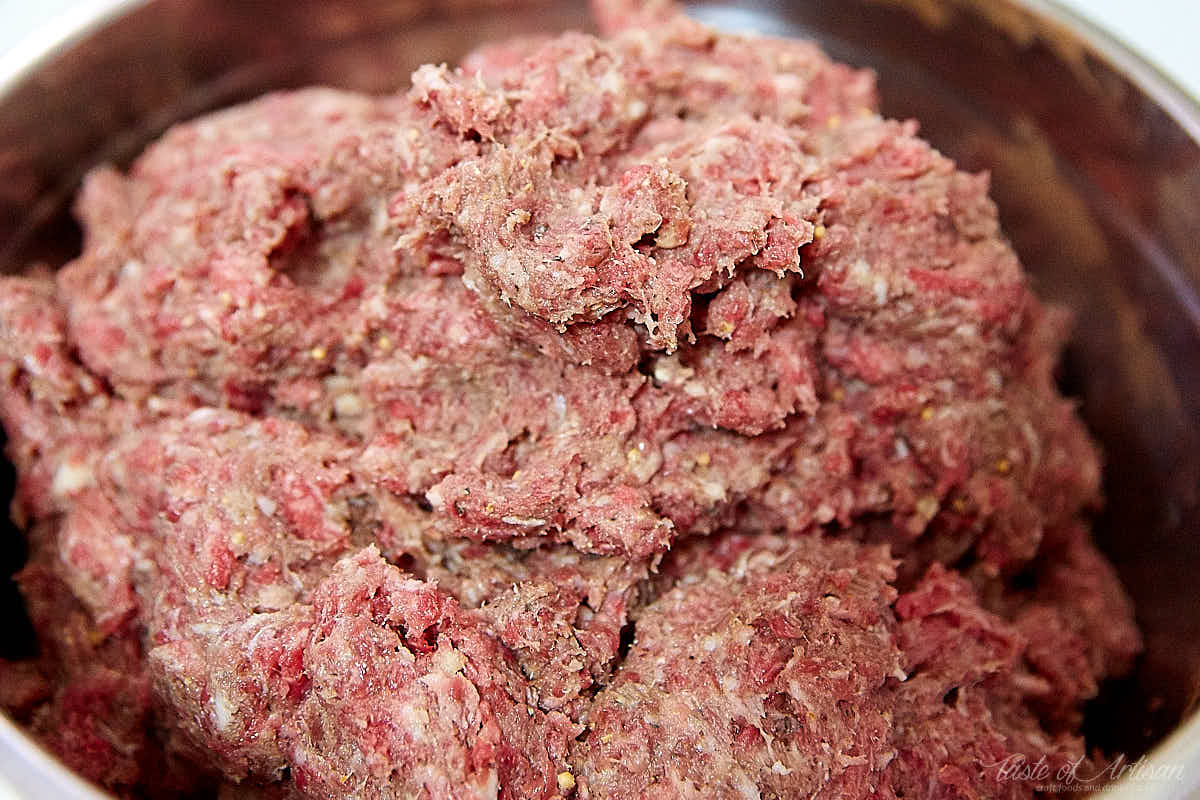
Sausage casings
First you will need the casings. The most common casing size used for summer sausage is 60mm in diameter, although 40mm to 120mm casings are also used. You can use beef middles, fibrous or collagen casings. I like to use collagen or fibrous casings for summer sausage and use them most of the time. Beef middles can be purchased from your local butcher, just ask someone who works there. They don't put them on display but will be happy to sell them to you if you ask. Collagen and fibrous sausage casings can be purchased from a variety of places, e.g. your local sausage making supply store, Amazon (Non-Edible Fibrous Casings), thesausagemaker.com, or butcher-packer.com.
Stuffing meat into casings
The most efficient and economical way to stuff the meat into casings is to use a vertical sausage stuffer, such as the LEM Products 5 Pound Sausage Stuffer that I use. These stuffers are not too expensive and do an excellent job. You may also use a sausage stuffer attachment for your meat grinder, but you may be disappointed with the results. Meat grinders are not designed for stuffing sausages and do a very mediocre job at it. I used one once and never wanted to use it again.
A cheaper alternative to a vertical sausage stuffer that would yield better results than a meat grinder attachment would be a manual sausage stuffer like the LEM Manual Sausage Stuffer. These stuffers are great for occasional use. They are hard to use and require good physical strength to operate, but can produce good results after some practice.
Stuff the meat firmly, ensuring that no air pockets remain inside. Getting all the air out is practically impossible and you will see some tiny cavities after your sausage is done. This is not a problem for semi-dry sausages. Just do your best but don't worry if some tiny air pockets remain.
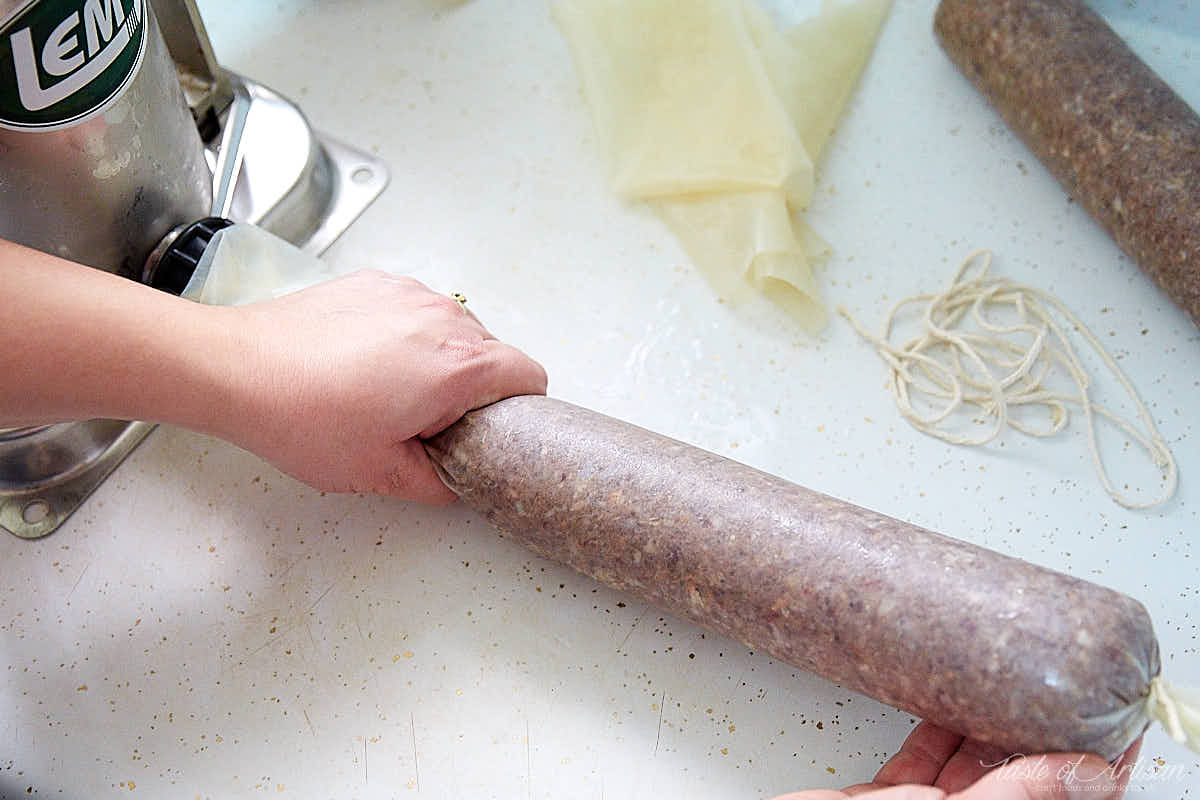
The cooking equipment
Electric smokers
Summer sausage is smoked, so you will need a smoker or a grill that is capable of maintaining low temperatures. A dedicated electric sausage smoker would be ideal, like the very popular Masterbuilt 30-Inch Black Electric Digital Smoker. Many people consider this smoker to be the best value for home sausage making needs.
Should you need a looking window to enjoy your food while it's being smoked, you can get an equally popular Masterbuilt 30-Inch Electric Smoker with Window and RF Controller. If you want one of the best looking and performing electric smokers on the market, Cabela's sells the Stainless Steel Pro 100 smoker that gets excellent reviews. It costs about 10 times as much as the basic Masterbuilt though.
Using a propane smoker
I do a lot of low heat and high heat smoking, so I try to compromise and use the Masterbuilt XL propane smoker. It's not that easy to maintain low temperatures with, but if I time my sausage smoking properly and do it on days with lower ambient temperatures it works fine.
Many people have had great results achieving low temperatures after modifying their propane smokers with needle valves, like the Bayou Classic Brass Control Valve. If you don't feel comfortable installing a needle valve into the gas line yourself, you can buy a pre-made gas assembly, like the Bayou Classic M5HPR-1 10 PSI Hose, Regulator, Valve Assembly
. You need to make sure that the regulator on the assembly you are buying matches the specs of your burner. Needle Valves for Gassers is a good resource for more information on this.
Other cooking equipment
Not too long ago I became a proud owner of the Big Green Egg and have successfully used it for smoking sausages at low heat. It's not too hard to start this grill at about 110F and maintain that temperature for about 1-2 hours. Eventually, the temperature will be begin to creep up but that's exactly what you want anyway. You just have to control the air flow such that the temperature does not rise too quickly.
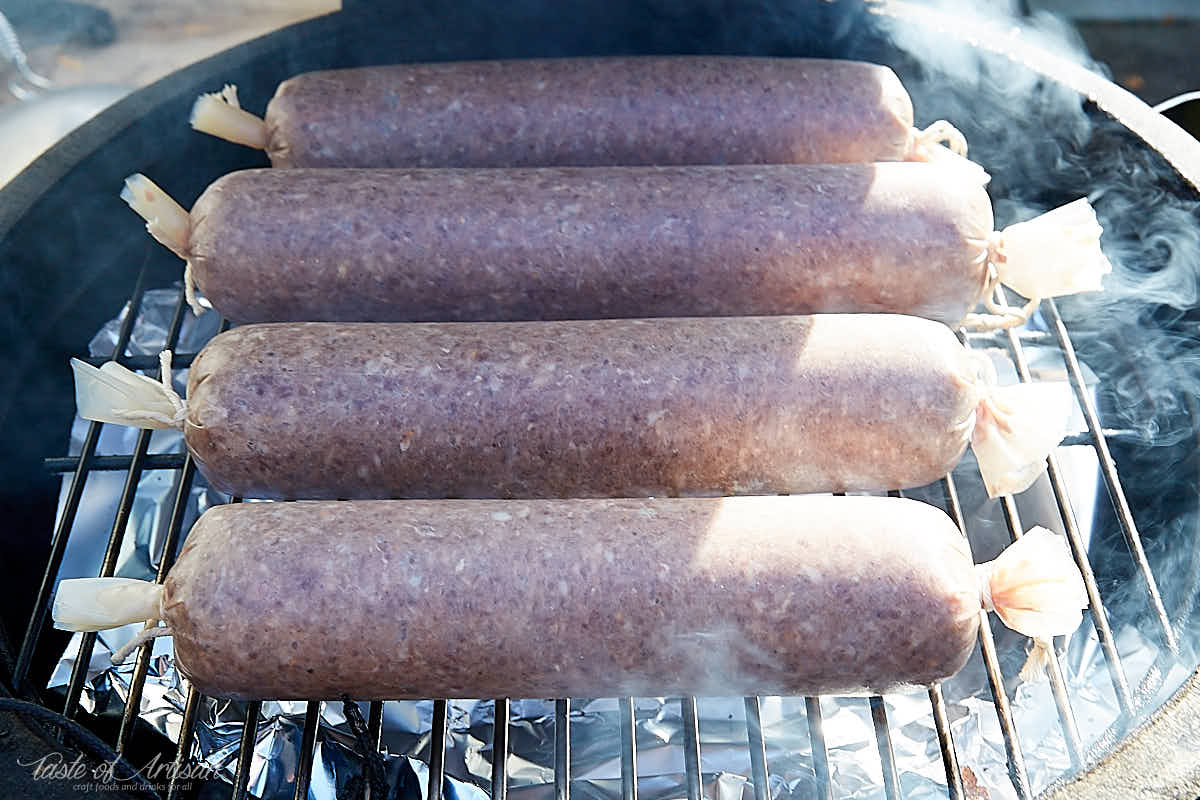
If you are a DIY type, you can look into building a low temperature sausage smoker. Stanley Marianski has an excellent book called Meat Smoking And Smokehouse Design that talks about different smoker designs that you can build at home.
If none of the above works for you, don't give up. You can cook your summer sausage in the kitchen oven. You won't get the same mind-blowing smoky flavor and the color, but it's still better than nothing. Just make sure to cook the sausage at low temperatures. This is very important.
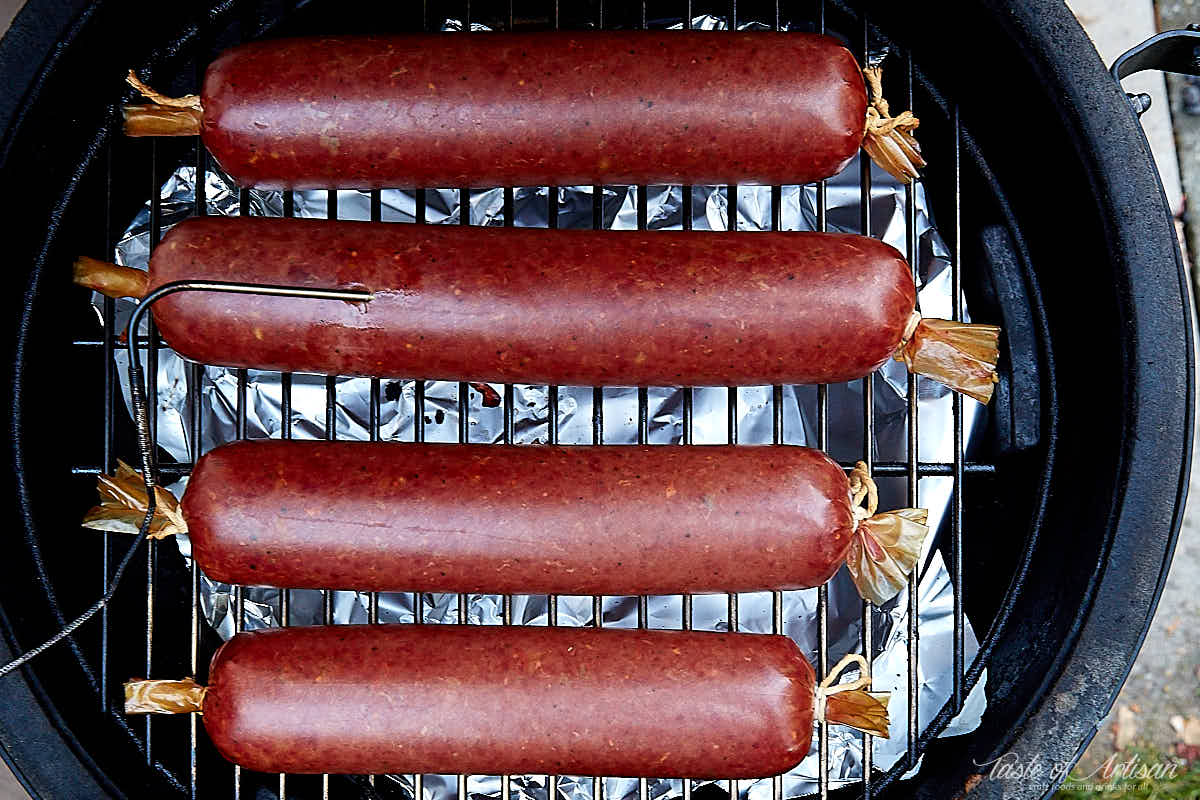
Cooking temperature
Stanley Marianski in his Home Production of Quality Meats and Sausages book mentions that once the temperature of the meat reaches about 100F all fat tissues become liquid. This is true regardless of the kind of meat. Once melted, the fat can move around the connective tissues, but still is not able to get out. There is very little fat loss between 150 - 190F or even up to the boiling point of water of 212F.
At temperatures over that mark, the fat starts to leak out quite rapidly. There is a significant fat loss at temperatures over 248F. Sausages cooked at temperatures higher than 190F will exhibit dry, crumbly texture. The higher the cooking temperature, the poorer the results will be.
When cooking your summer sausage in a smoker or on the grill, smoke at 110F – 130F until the desired color is achieved, then gradually increase the temperature to 150-175F and then all the way to 190F. When cooking in the oven, start cooking the sausage at the lowest setting (usually around 170F) and slowly increase to 190F, until the internal temperature of the sausage reaches the target temperature.
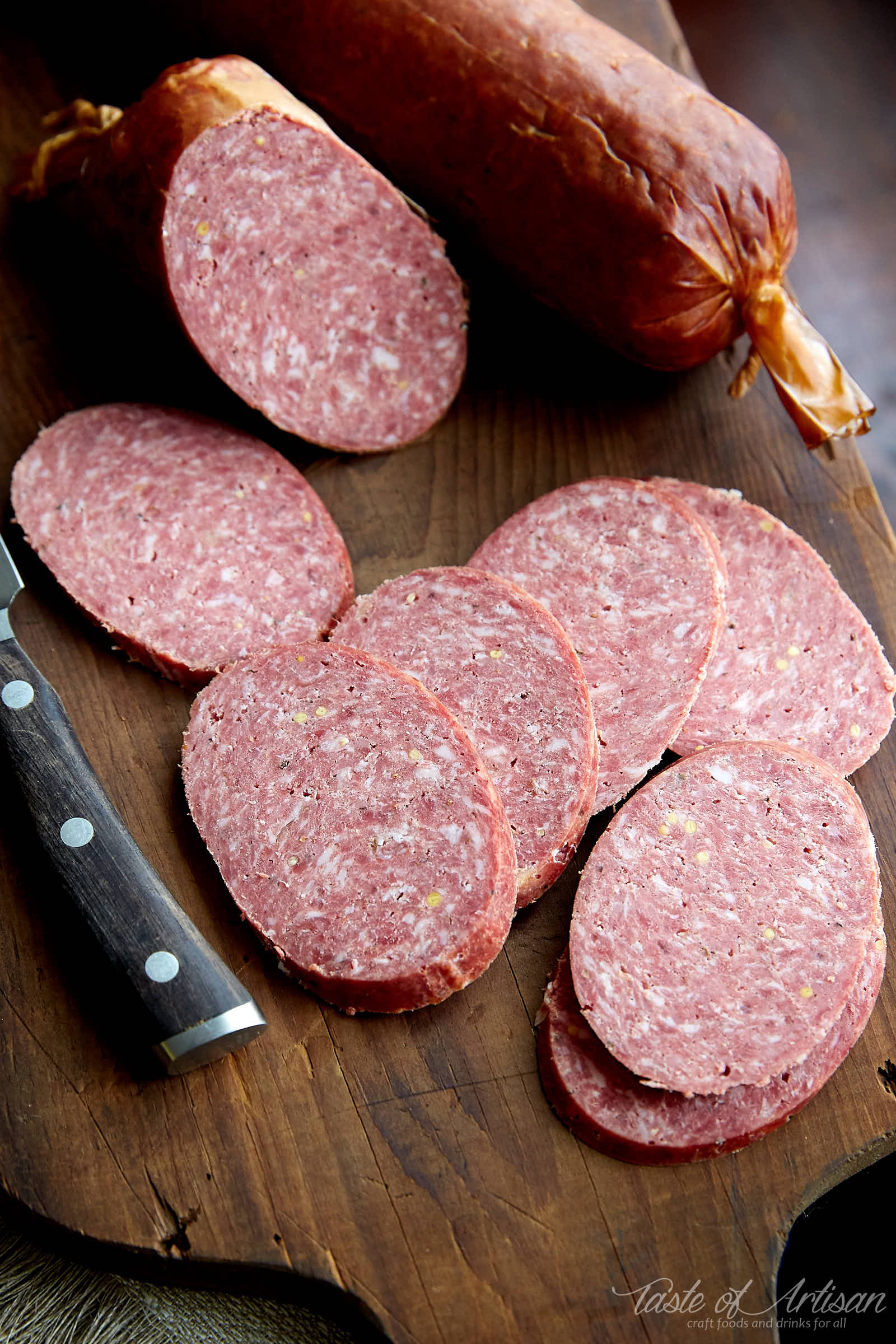
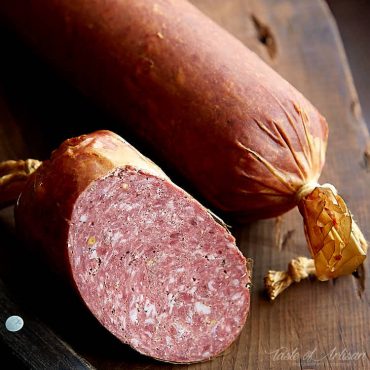
How To Make Summer Sausage
Ingredients
- 700 g beef chuck (about 1.54 lbs)
- 300 g pork butt (about 0.66 lbs)
- 23 g salt (about 4 tsp)
- 2.5 g Cure #1 (about 1/2 tsp)
- 10 g dextrose (or glucose; about 2 tsp)
- 5 g sugar - 5.0 g (about 1 tsp)
- 3 g black pepper (ground, about 1½ tsp)
- 2 g coriander (ground, about 1 tsp)
- 4 g whole mustard seeds (about 1 1/2 tsp)
- 2 g allspice (about 1 tsp)
- 3.5 g garlic (about 1 clove)
- 0.24 g F-LC culture (use scale)
Instructions
- Grind pork and beef through 3/16” plate (5 mm).
- Mix all ingredients with ground meat.
- Stuff into beef middles or fibrous casings about 60 mm in diameter.
- Ferment at 86F (30C) and 85-90% humidity for 24 hours.
- Place the sausage in the smoker and smoke at 110F and 70% humidity for 6 hours. Gradually increase smoke temperature until internal meat temperature reaches 140F.
- For a drier sausage, dry for 3 days at 60-70F and 65-75% humidity or until desired weight loss is achieved.
- Store sausages at 50-59F and 75-80% humidity.
Nutrition
An alternative way to make summer sausage
The recipe above is for traditional Summer Sausage. It calls for a 24-hour fermentation that requires a temperature/humidity controller, as well as a heating pad or something similar. I typically ferment sausages by putting them in a large cooler partially covered with Saran wrap. Water released from the sausage will ensure RH of about 90-95%, which is perfect for fermentation. A heating pad will help keep the temperature at 86F. Both the temperature of 86F and the high humidity are critical for proper fermentation.
If creating those conditions is a challenge, here is another recipe that I have been using to make summer sausage. It makes a great tasting product. This recipe has been adapted from Great Sausage Recipes and Meat Curing by Rytek Kutas. To give the sausage that coveted tang typically produced by the process of fermentation, the recipe uses a product called Fermento, available online from the Sausage Maker or Amazon.
Semi-Dry Cured Ukrainian Summer Sausage (without fermentation)
- 7 1/2 lbs lean beef
- 2 1/2 lbs pork butts
- 5 Tbsp salt
- 2 tsp Cure #1
- 1 Tbsp paprika
- 1 Tbsp whole pepper
- 2 small garlic cloves, pressed
- 1 tsp marjoram
- 4 Tbsp corn syrup solids (I normally skip this ingredient)
- 6 Tbsp powdered dextrose
- 3/4 cup Fermento
- Grind pork through a 1/4" grinder plate and beef through a 3/8" grinder plate.
- Add the remaining ingredients and mix until all ingredients are evenly distributed.
- Stuff the meat into 38-40 mm or 40-43 mm pork or beef casings. The casings should be filled 15-18" long, leaving at least 3-4" on each end for tying.
- Hang the sausages on a stick at room temperature of 65-70F for 3 hours.The sausages will have the surface dry and ready for smoking by that time. If still wet, let them dry for another hour or so.
- Put the sausages in the smoker preheated to 165F and apply heavy smoke for 2 hours.
- Continue cooking until the the internal sausage temperature reaches 152F. You may need to gradually raise the smoker temperature above 165F to achieve that.
- Remove the sausages from the smoker and hang at room temperature (60F - 70F) overnight to cool.
- Apply dense cold smoke for another 12 hours until reddish-brown color is achieved.
- Air dry the sausages at 50-60F and RH of 70-75% until about 15% weight loss is achieved. The sausage is ready to eat at this point.
This post was updated on January 26, 2019

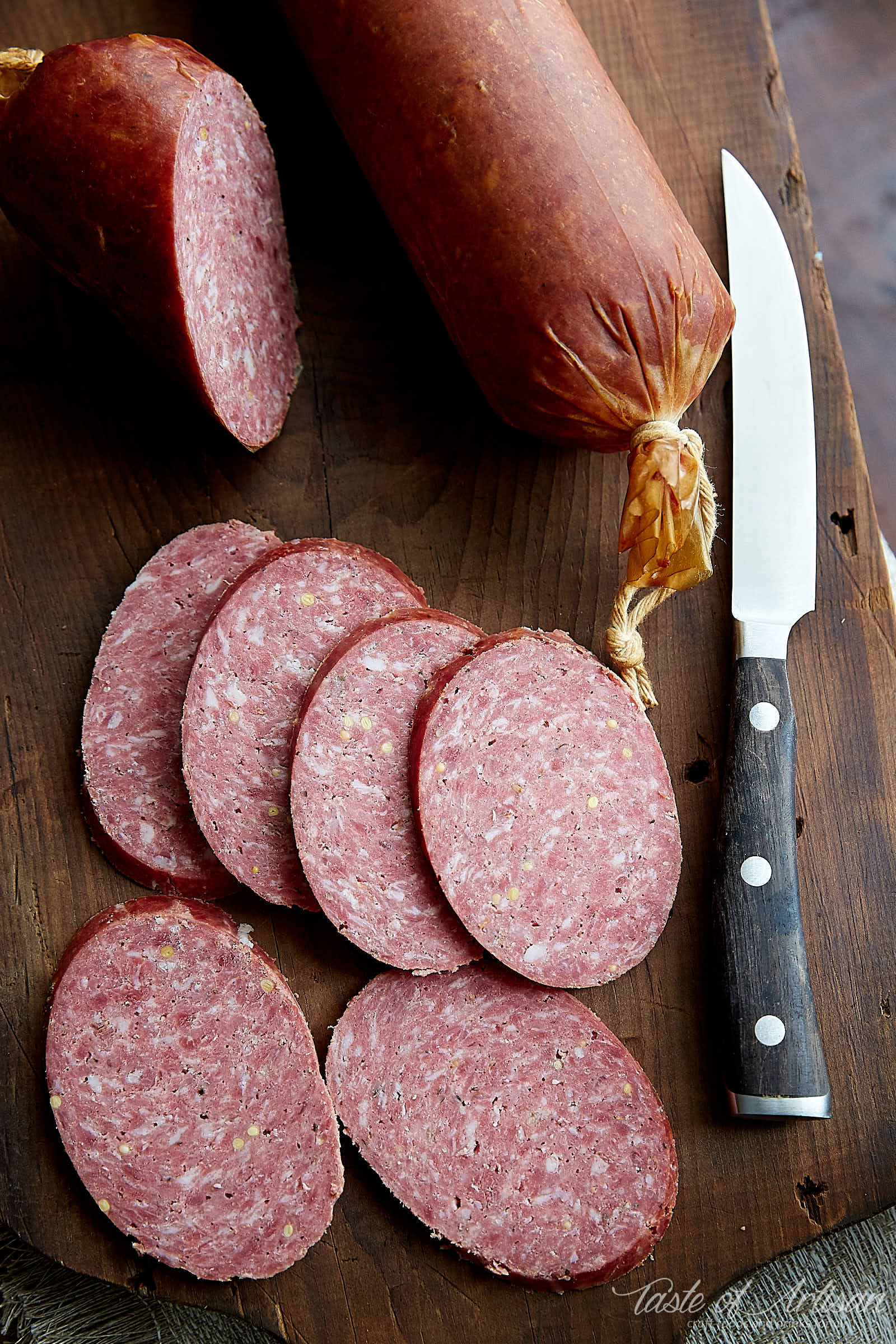

Alex says
Hi
Can i make this whitout T-LC i just finish 15 kg batch and is little bit tung ( sour )???
Victor @ Taste of Artisan says
Totally fine without it. Good luck!
Tim says
Could you tell me the recommended amount of dry butter milk to replace the F-L culture?
Is there a replacement for the dextrose?
Victor @ Taste of Artisan says
You can start at 2 oz (60g) per 5 lb of milk. You won't need dextrose if using buttermilk powder, it's only needed in combination with a starter culture to feed it.
Timothy Morin says
Oh, forgot to add I used about 70% pork butt and 30% beef. Pork is less expensive!
Timothy Morin says
Just tasted my summer sausage from this recipe. It's very good! Maybe not hickory farms quality, but very good!
I used 65mm collagen casings with a 1" stuffing tube. That worked fine! The fermentation was about 20 hours and smoked on my pellet grill at 160 degrees for 5 hours. Not as salty as some summer sausages I have had, but maybe that's a good thing! Thank you.
Victor @ Taste of Artisan says
Glad you liked it. Thanks for your feedback. I tend to use lower amounts of salt (as well as less fat, etc.) to make my sausages a bit healthier, that's the reason why. Enjoy.
Rocky Keim says
Excellent article. Informative to the max! Enjoyable to read. Thank you.
Joe Mara says
What are its nutritional facts?
Victor @ Taste of Artisan says
Added
Aaron Rasko says
Very interested in this recipe. I have made a lot of summer sausage but am very hesitant to do anything as far as fermenting and I have never tried to air dry a product as in your second recipe. Is the air drying a necessary step in the second recipe? I do not have a drying room or a way to track weight loss. Thank you very much
Victor @ Taste of Artisan says
If you are hesitant to do fermentation you can mimic it by using buttermilk powder. Air drying is optional, but I think it really benefits the sausage, making it firmer, with concentrated flavor. You can do it in a fridge. Just keep the sausage open and and flip and shuffle regularly.
Nancy says
Can not wait to try.
Victor @ Taste of Artisan says
Good luck! I hope it turns out great.
Chris Gebhard says
I don't understand where the recipe for your "Ukrainian Summer Sausage" came from? In all my research on Ukrainian sausages I have never run across anything similar. And Fermento, how does that tie into any Ukrainian sausage? If you can enlighten me on the provenance of that sausage I would be very grateful.
Victor @ Taste of Artisan says
I mentioned and linked the source of this recipe right above the recipe itself, looks like you missed it. It's from Rytek Kutases book. I found it as an interesting alternative when I was writing my post so I thought it was worth mentioning. You can also use dried buttermilk in place of Fermento which, as I learned later, is essentially the same thing.
If you are saying that this recipe is not an authentic Ukrainian sausage recipe, I am not going to argue with you. It's not, despite the name, as is the case with many 'regional' sausages sold/described in America/American recipe books, e.g. Italian, German, Polish, etc. Paprika and corn syrup solids are immediate giveaways, and that's just a start. But it's a good alternative summer sausage recipe that doesn't use fermentation.
Dan Schiller says
Well, I finally got around to trying it! Have never tried this before or even tried stuffing a sausage, or smoking meat, but I am very pleased with the results! your seasonings are bang on and I smoked it on a regular Natural Gas BBQ with a smoker attachment!. The only thing that I'm missing is a little more tang to the sausage. I've been reading that many recipes add "encapsulated citric acid". Have you heard of this? Can this be added? Other recipes also use binders and water - not sure why?
Anyway, thought I'd share my rookie adventure with you! Thanks again for the recipe and guidance!
Dan
P.S. I don't think photos sent correctly - but they look amazing!
https://tasteofartisan.com/wp-content/uploads/2024/02/IMG_0700.jpg
https://tasteofartisan.com/wp-content/uploads/2024/02/IMG_0701.jpg
Victor @ Taste of Artisan says
Dan, I am surprised your sausage lacked tang. Next time you could double the amount of the starter and sugar and/or let it ferment a longer.
Never tried using citric acid but heard of it. I did use Fermento some years back and later switched to powdered buttermilk, which is essentially it, only cheaper and much more accessible. Now I make my own kefir, which I dry and use to make some types of sausage. I love it. It adds great flavor and a nice tang. I have a few sausage recipes with powdred buttermilk/kefir on my site.
Binders and water help with weight and moisture retention/juiciness. Commercial producers love using those. Which is exactly the opposite of what I like. A lot of my smoked sausage spends a week or two in the cold room, curing chamber or garage during cold months to dry a little. The flavor becomes more concentrated and the texture is drier and, IMHO, much better. Good luck!
Dan says
Thanks for the feed back! Yes I have seen some of your recipes using buttermilk powder. May try that next time. Really interested in trying your smoked pepperoni - that's my next adventure!
Thanks again for these great recipes and all your guidance!
Dan
Victor @ Taste of Artisan says
You are welcome.
Victor @ Taste of Artisan says
Thanks for sharing pictures of your summer sausage, Dan. I attached them to your post. Looks great! Enjoy!!!
Dan Schiller says
I am just about to try this summer sausage recipe-it looks amazing!
The question is how do I know when I have reached the correct temperature?
I've been told to start slowly (around 130)and then increase by 10 degrees every hour until I reach an internal temp of 140. Then dowse in and ice bath. Does this sound right?
Also how do I check the temp? I have a probe thermometer but am scared to prick through the casings. is this an issue?
Looking forward to trying this!
Victor @ Taste of Artisan says
Dan, I use a BBQ thermometer with a probe, which is inserted into one of the sausages. There is no harm in poking one of them. Hope this helps. Happy smoking!
Dan Schiller says
Great! I have one as well . I will use that. Thanks
Dan Schiller says
HI Victor, one more quick question. In the ingredients you stated to use .24g of F-LC culture. Did you mean 24grams or 0.24 (roughly 1/4 of a gram)? It's very expensive to get F-LC culture here in Ontario Canada, so I want to make sure I have this calculation correct.
Is there a substitute for F-LC culture?
Appreciate your time with this.
Thanks
Victor @ Taste of Artisan says
Hi Dan, .24 is correct. 24 grams is too much, it's enough for almost 220 lbs of meat. If you are in Ontario, try the sausagemaker in Buffalo if you live close to the border, or Yes Group in Toronto, they should have it.
Jason Christensen says
Tried this recipe this past weekend in two batches, I used SM-194 culture which required 24-30 hours to ferment and it turned out great.
One batch I added high temp cheddar and while the taste and texture of the sausage was fine, the cheese turned out a bit off color and grainy, any idea why?
Victor @ Taste of Artisan says
Can't help with that as I've never used a high temp cheese in my sausages. Regular cheddar seems to work just fine. Maybe it's the cheese itself? Does it need a specific tremp range for cooking? I make cheddar and jalapeno sausage with regular cheddar pretty regualrly and never had a problem with it.
Frank W. says
Hello again Vic,
Any reason why collagen casings wouldn't work with this summer sausage recipe?
Although fibrous casings work I'm not especially fond of using them since they don't always shrink with the meat when it cools.
What say you?
Have a Merry Christmas.
Frank
Jennings, FL
Victor @ Taste of Artisan says
Hi Frank,
Either will work fine. I use them interchangeably. I also use beef middles sometimes, if I have them on hand. I don't normally have the problem of casing not shrinking with the meat, but I suspect that's because I tend to stuff my casing very tightly.
Happy smoking and Merry Christmas, Frank.
Al the best!
Wayne Tomaszewski says
It's getting that time again soon for summer sausage made with deer and pork butt, 50-50, in the Midwest. We generally make them from the end of February to mid March, and hang them outside to dry after smoking. We use fibrous casings and stuff about 18" long, using a process close to your Ukrainian style. My question is, since you got me spoiled now, do see why there would be a problem with poaching these to finish them off? I hate cranking up the smoker past 170 because of liquifying the fat, and it seems like every sausage I make now, I finish off by poaching. LOL. It's so easy and what a time saver, plus the flavor stays outstanding. Wish I would have known this trick ages ago, sure would have saved hours watching the smoker doing it's slow process smoke. Thanks again for taking your time to teach all of us.
Victor @ Taste of Artisan says
You are so very welcome, Wayne. I am very glad I was able to help, that's the main goal behind my blog: share great recipes, share useful tips and tricks, help others discover artisan foods and teach how to make them at home.
To your question, no, I don't see why that would be an issue. Fibrous or natural, it doesn't matter. A mix of venison and pork is fine too. I've poached sausages in fibrous casings and they do just as well.
One thing I'd like to remind of, when you poach larger caliber sausages and/or do it outside in colder weather, bring the water to 176F, and when poaching thinner sausages, 20-138mm and when its warm outside, you can even start at 168F. No fat melt.
Good luck, Wayne! Venison sausage sounds fantastic!
Brandy says
Is the second recipe, that doesn’t require fermentation, shelf stable?
Victor @ Taste of Artisan says
Both have very similar shelf life.
Matt says
Ok, so just to verify, you can skip the cold smoking in step 8 and still end up with shelf stable sausages? So ultimately, you're smoking them to temp, and then hanging in a 60 degree room with the right humidity and they're shelf stable? Is it really that simple? What's the difference between the finished product whether cold smoked or not?
Victor @ Taste of Artisan says
Well, even though smoking is another preservation method, the smoke particles have bactericidal properties, the water activity is what essentially matters the most. Cure #1 is another perservative that prevents pathogenic bacteria from from growing exponentially while you are getting to the safe water activitu level. This is the principle behing making salami which isn't typically smoked. Take beef jerky for example. You can dry it without smoking until it's bone dry and you don't need to refrigerte it, and it will last many months at room temp. Bacteria need water to grow.
Mike says
How do you (Ferment at 86F (30C) and 85-90% humidity for 24 hours)? Am I missing a link or something, but what is the process here, where do I do that...Sorry not sure I saw where that is mentioned. Thanks
Victor @ Taste of Artisan says
I do it in my curing chamber. I used to do it in make-shift fermentation chambers, like a large cooler with a small heating mat or in a bathroom with a small heater. I've done it in an oven with a pilot light on - it maintains a perfect 85-86f. Plug the vents and the hunidity will be right where it needs to be. Time to get creative, there are many ways to do it. Good luck!
Sherry Maxwell says
We have been making a family summer sausage recipe that has been made in the oven for years. Our recipe uses beef only, and it is wrapped in foil, not a casting. It'sa very good product. We recently tried a beef/vendi9n vombo and felt it was too dry. . We are wanting to try a beef/pork mix or pork only, but unsure if this will work in the oven; if there should be spice changes, oven temp changes, etc. Could you advise us. I could send you our recipe fir youvto look at.
Victor @ Taste of Artisan says
Beef/venison combo should be supplemented with pork fat or fatty pork trimmings, you will need at least 25% of fat but higher will be better. The more venison you have in there the more this becomes critical. Beef/pork should be fine as long as you have a sufficient amount of fat, that's what makes sausage good. Pork butt for example is perfect for sausage and has about 30% fat content on average. Some commercial sausages go as high as 50-55% fat. I don't cook sausage in the oven so I can't recommend on the cooking temp, especially the ones wrapped in foil. But seasonings should not change in any way. Good luck!
Mark Garlock says
I do mine in the oven also with great results. I use 2lbs beef to 1 lb pork.
Darin Dalida says
This recipe is an absolute winner. I'm good in the kitchen but had never made sausage. Like a fool I didn't take it slow - I started by doubling this recipe and the result was absolute perfection. It did not last long as my kids circled like vultures. Over the weekend I made 9lbs of this stuff - again, came out perfectly. While I may have bumped up the garlic for my own liking - I left the rest intact...the tangy flavor is spot on.
Fermented the sausage in a cooler on a rack with a towel I doused in boiling water. Smoked on my pellet grill. Very satisfied with how the recipe shined even though the means for fermenting and smoking were different. Great site. Keep up the good work!
Victor @ Taste of Artisan says
Thank you for the kind words, Darin. Glad you liked the sausage. Try my other sausage and non-sausage recipes. Enjoy!
John says
I have been making and smoking sausage for long time for our own use , this sounds good and learning is always good.
Victor @ Taste of Artisan says
Good luck, John. Hope it turns out great.
Thomas Stubblefield says
First time making summer sausage and it came out perfect. Great recipe.
Joe says
I made this sausage to a "t" and it was amazing. Everyone I shared it with commented how good it is, some even saying it's the best summer sausage they've ever had. Thank you so much for such a great write-up, it was a fun project.
Question: if you were to make a cheddar jalapeno version of this, how would you modify the recipe, other than adding those ingredients? I read a couple of other recipes on the internet that mention adding high-temp cheese at a rate of 10-15% of the weight of your meat. That seems easy enough - but for jalapenos, do you want to use freeze dried peppers, or fresh? If freeze dried, do you rehydrate them ahead of time, or just add the dry peppers to the meat and put through the grinder? Is there a rule of thumb for how much weight in peppers to add as a percentage of meat weight?
Thanks again!
Victor @ Taste of Artisan says
Joe, good to hear that.
I have a recipe for my favorite fresh jalapeno/cheddar sausage on the blog. In it, I use 4 jalapenos per 2.5 lbs of meat, this works well. I like to use fresh jalapenos, they add the most natural flavor/taste. Never tried freeze-dried but that sounds interesting, I would try that. Don't rehydrate, just use as is as you would dry herbs.
Joe says
Oooh, that fresh sausage looks great! Thanks for the advice!
Victor @ Taste of Artisan says
You are welcome. Enjoy!
Ron Ely says
I dry my jalapenos (seeds and all) and grind them with a pepper mill. ½ tsp = ~1 med size jalapeno. The flavor is still there and evenly distributed through out the sausages I make.
Ron Ely
Ein Deutscher Wursthersteller
Victor @ Taste of Artisan says
That's a very timely tip - I had a couple of dozen jalapenos in my garden that started drying on the plants so I moved them to the pantry and they finished drying there. Curious to try them in my sausages. Thank you.
Brian says
The fiberous casing doesn’t peel easily off the salami smoked to 155F. What is my problem and what is the solution
Victor @ Taste of Artisan says
Usually happens when the meat is not mixed well enough and - more common - when the sausage is cooked at high temps for too long. Try to shorten the cooking time - adding humidity (a hot water pan) helps expedite that. Once done, cool down quickly - a cold water bath or a shower. Finally, soak the cooled down / refrigerated sausage in worm water for 10 minutes or so, the casing will soften up and should come off easily.
Stu says
Run hot water over the cased meat. It will bring a very little grease to the top and casing will peel right off.
Anthony Vella says
This was so helpful to read, so thank you! I am wanting to purchase a pellet grill/smoker, namely for it’s assumed potential at smoking the Summer Sausage. Have you ever heard of people using these?
Victor @ Taste of Artisan says
Hi Anthony, you can smoke summer and many other sausages on just about any grill/smoker, you just have to be prepared for its limitations and, believe me, every single one of them will have some limitations. I have never used a pellet smoker but I have heard that they can't go lower than 180F-200F. I've smoked this sausage on my Weber and BGE grills though, they also smoke at quite high temps for a sausage, with very good results. The main problem when smoking at higher temps is fat melting but I'd let the sausage cool then refrigerate, the fat would solidify and it would look perfect. A smokehouse would be ideal for making smoked sausages but that comes with own challenges. My buddy has an electric Masterbuilt smoker and he loves his. It's capable of making great sausages though his are not as smoky as mine and the texture is a little different... but that's probably me being a little picky;)
Frank W. says
https://photos.app.goo.gl/ebXFyt5JVBDBQSup6
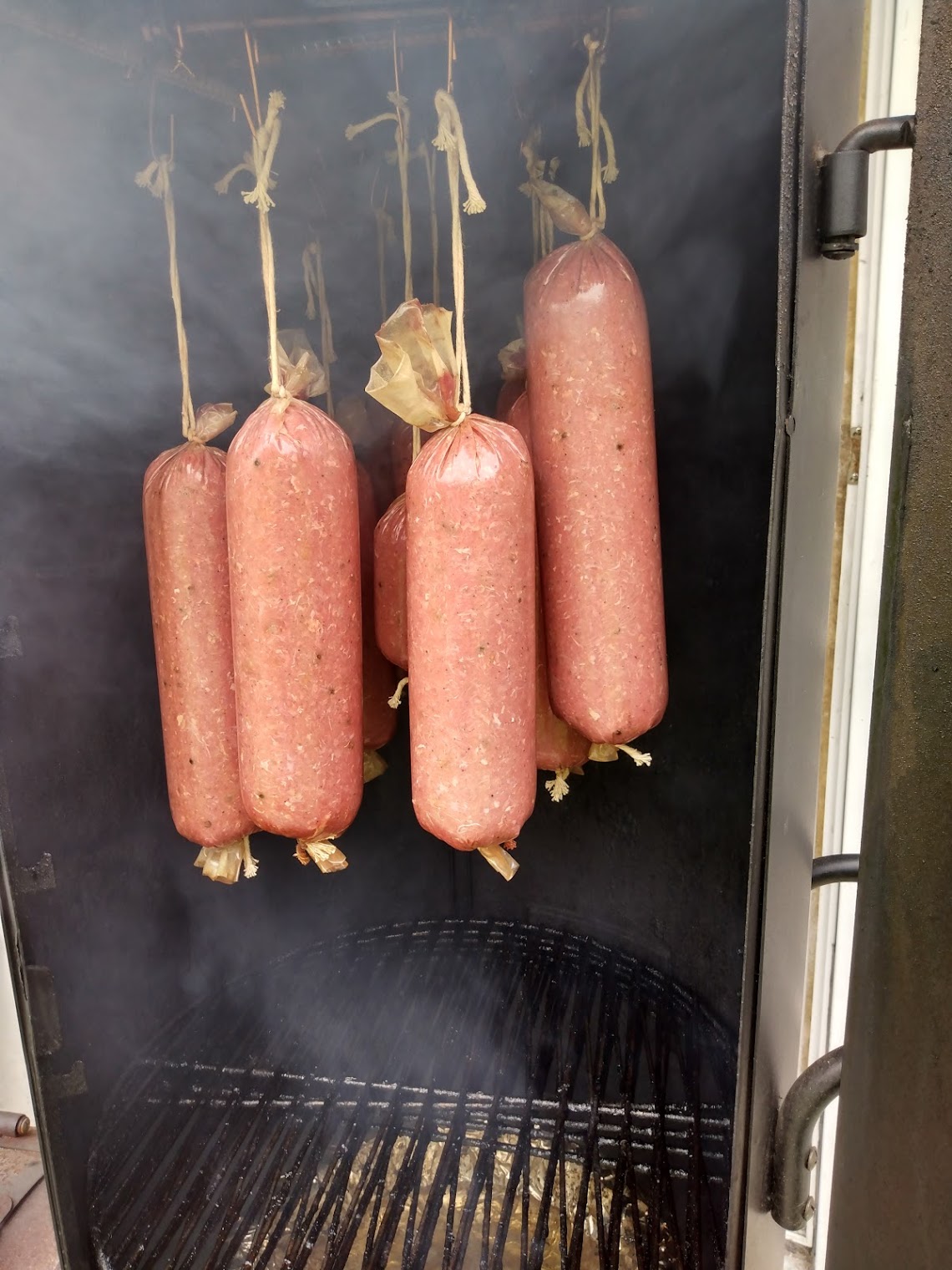
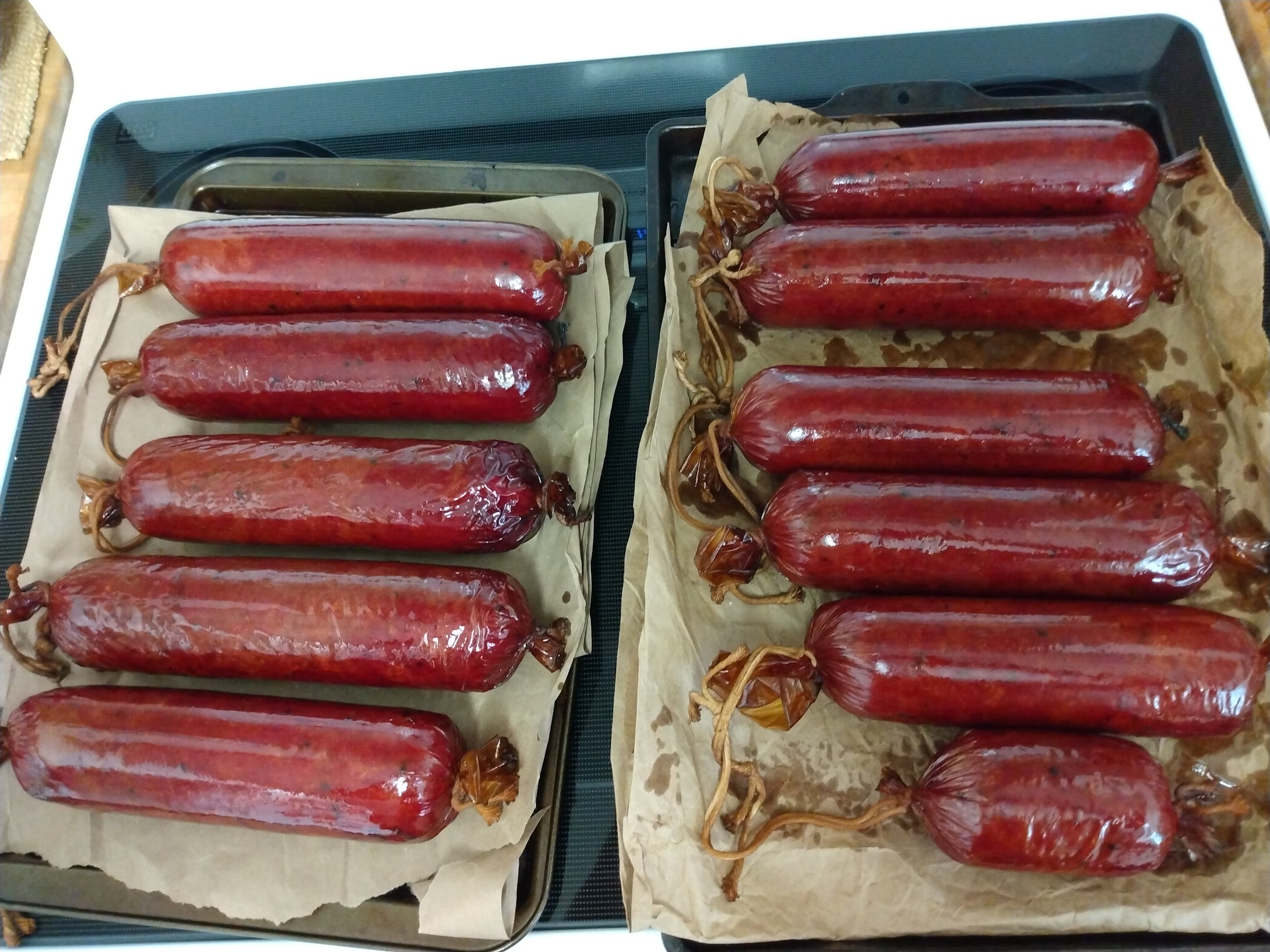
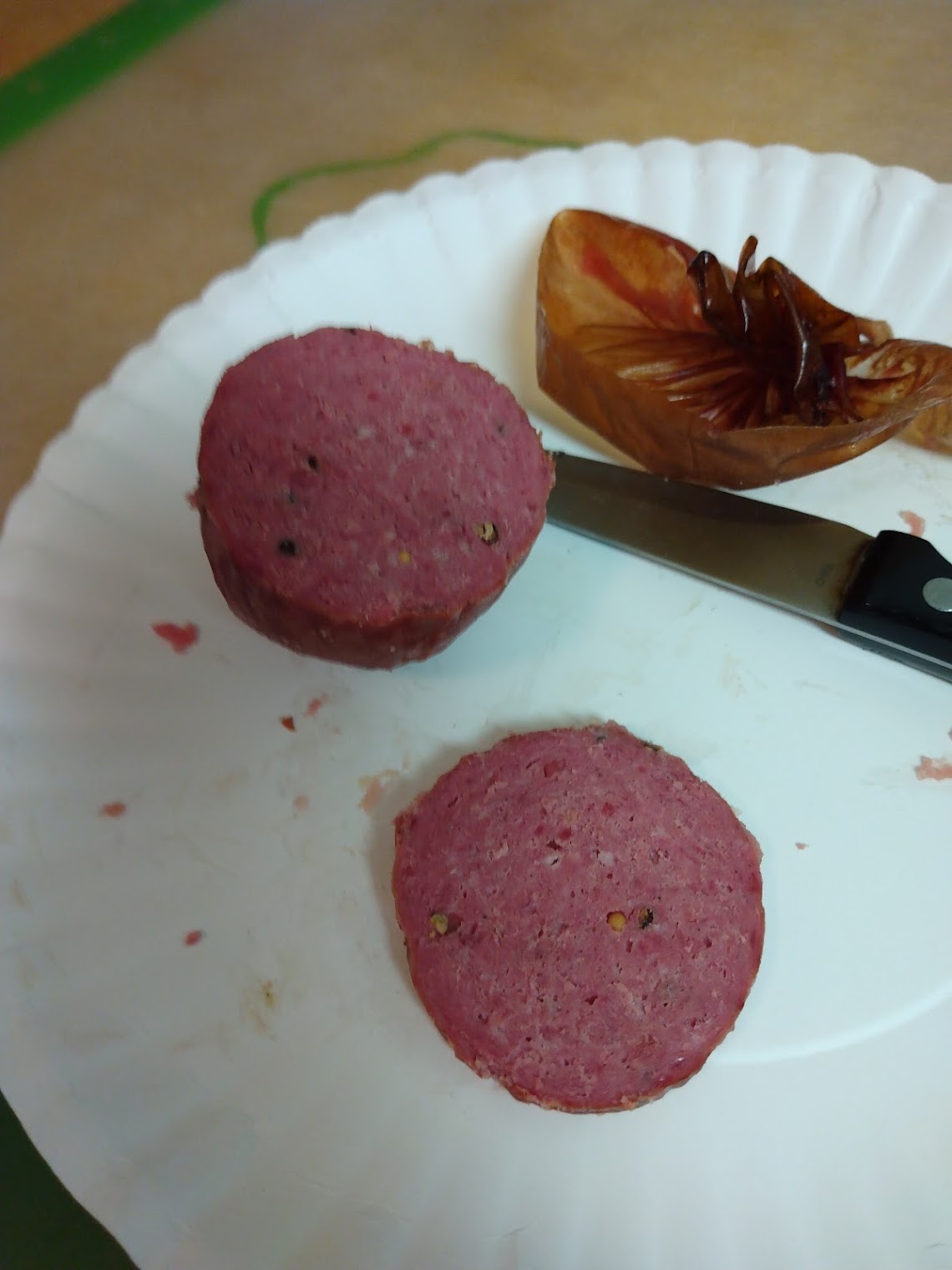
Victor,
Frank W. Here again. I forgot to send you some pics of my summer sausage project no 2.
Please forgive my inability to post them. I consider myself "technologically challenged." Perhaps you can post them in my comment?
Stay well, my friend.
Frank W.
Jennings, FL
Victor @ Taste of Artisan says
Hi Frank, thank you for the pictures, the sausages look great.
P.S. You are not technologically challenged, WordPress is... lol... Only the admin can attach pictures, users can't. It's best to email them to me and I will attach.
Frank W. says
Hello Victor,
Your recipe and process for making this sausage has been invaluable. Although I did alter the meat rations, the results have been EXCELLENT! I've enjoyed making this particular sausage so much that in the past 2 months I have made 26 lbs of it. Everyone I let sample it wants to buy some and I end up giving some away to friends and family.
I have a question.
What is your thoughts on making this recipe using mostly venison? I have a considerable amount of ground venison in the freezer and would like to use it for this recipe. For fat: Beef, pork or fat back?
Would any of the fermentation parameters change? Anything you can tell me would be helpful.
Last, I've copied the smoked kielbasa recipe from you as well.
Excellent.
Thanks again,
Frank
Jennings, Fl.
Victor @ Taste of Artisan says
Hi Frank, glad to hear that you like my recipes. To your questions, pork fat is better, you can use pork trimmings, belly, fatback. All will work fine. I typically save fastback for salami and use fatty belly pieces and trimmings for sausages. Someone asked me a similar question regarding moose meat, don't want to repeat the same thing so please check my response on January 01, 2020 at 10:29 pm. Good luck!
Dan Brewer says
your the best.i will not try anyone elses recipe.tks
Victor @ Taste of Artisan says
😉
Richard says
I’ve ordered some F-LC culture, but am wondering if I could have inoculated with sourdough starter? Thanks for a wonderful recipe. I’m looking forward to trying it with a venison/pork combination next week.
Victor @ Taste of Artisan says
Hi Richard, you are very welcome. I have not seen any descriptions of using sourdough starter culture or fermented products like yogurt for sausage making in any scientific literature. I am sure it has been done to a lesser or a greater degree somewhere and some time. Is it a good idea? I am not sure about sourdough starter but I've come across a few forum members from Poland and Turkey inoculating their dry-cured sausages with yogurt following some old traditional recipes. Personally, I don't have any of those recipes and have no good idea about the process. Since I bake sourdough bread several times a week, I am quite familiar with sourdough starters. They are not created equal, they change their qualities with ambient temp changes, I am sure you know what I am talking about. What you feed them, temp changes and other factors impact the strains in it that dominate. Not all of them will be good for acidifying and flavoring your sausage. With FL-C, you know what strains you get, their quantity and optimal acidification temperature for them. You also get bioprotective qualities. With sourdough, you don't know exactly what kind of results you will get. Interesting topic though, I'd like to experiment more in this area and see if I can find some studies on this. I like to go organic and natural as much as I can as long as safety and quality are not sacrificed.
Daniel A. Dernbach says
Is your summer sausage delicious without smoking. And if you do smoke can I use my Treager smoker without OVERSMOKING the sausage since you cant control the amount of smoke with the Treager ?
Thanks Dan Dernbach
4066994000
Victor @ Taste of Artisan says
Daniel, yes, you could cook this sausage without smoking it will be plenty flavorful. As far as over smoking and using a Traeger pellet smoker, there are a few things you could try. For example, you could smoke the sausage on the Traeger until the desired smokiness is achieved, then finish in an oven or poach in hot water until ready. Also, keep in mind that you won't be consuming the skin on this sausage so a lot of that smokiness will go away once you remove the skin...
Dave says
Here is my ratio for prague powder #1, sugar, and salt, in grams.
Cure #1 0.0025 multiply by weight of meat
Salt 0.03 multiply by weight of meat
Sugar 0.0125 multiply by weight of meat
Weigh meat in grams. An example: 5lbs equals 2268g times 0.0025 equals 5.67 grams of PP #1.
The results is 156ppm nitrate concentration, which is ideal.
Please correct me if I’m wrong.
Victor @ Taste of Artisan says
Sounds about right, Dave. I use 1g of Cure #1 per pound of meat. 3% salt is a bit too much for my taste but as they say, tastes differ.
Ashly says
Me again! 🙂 do you have a post with the specifics on fermenting? Specifically the little "green house" you created to maintain temp/humidity. I saw your post in this comment section and have made that, but I'm having a hard time getting my whole sausage to warm up. Just the part that's touching the mat is the right temp.
Victor @ Taste of Artisan says
Ashly, you could use something like my curing chamber which I also use for fermentation when it's not occupied. I added a heating mat to bring up the temperature. A controller like Auber or inexpensive Inkbird will help with that. I've also fermented a number of times in my kitchen oven. With the oven light on I get a perfect 83F. If the dampers are closed, the rH is around 90%, perfect for fermentation.
Pete says
I would like to try recipe. Just wondering about the cooler/heating pad fermentation setup.
Victor @ Taste of Artisan says
What specifically do you have questions about?
Fred Jensen says
Hi Victor, I'm making venison / pork summer sausage. I want the texture to be smooth. Should I emulsify the venison to make a smother texture?
Victor @ Taste of Artisan says
Hi Fred,
yes, emulsifying or even grinding through a 3mm (1/8") plate will do. Adding a little extra fat will help too. I will be posting my recipe for chicken sausage that I make with whole chicken - lot's of white meat there but the sausage is smooth, all because of the finer grind and adding some chicken fat and chicken skins.
Ashly says
If I wanted to add cheese to this recipe, is there anything different I would do? Do you know about how much of the high temp cheese you would add?
p.s. thanks so much for all the helpful information and links. I'm a first time sausage maker I'm so glad I stumbled upon your website.
Victor @ Taste of Artisan says
Ashley, 15%-20% would be a good ratio. I make ridiculously good jalapeno cheddar sausage, love it, I add 20% cheddar in it. It works very well.
George Lathrop says
I am looking PH meters for fermenting meat. Does anyone have a suggestion for an affordable instrument.
Scot says
I am going to use your recipe for the first time. I have a three pound chuck roast and I am cooking a 13 pound brisket for 4th of July. Always trim my brisket before smoking it. I would like to do just a beef sausage. Any tips for using my brisket trim in this recipe. My thought is I won't be able to use all the fat. Thanks in advance.
Victor @ Taste of Artisan says
Scot, with all-beef sausages I find that the best ratio is about 80/20 - 75/25 meat to fat. Chuck is about 20-30% fat, depending on how much you trim off. That's plenty. Adding more fat would make the sausage a little too fatty, I don't think you will like it. One of my favourite all-beef sausages is smoked beef sticks, I use a 80/20 ratio in that recipe and find it excellent, wouldn't want to add more fat.
Scot says
Thanks for the advice. Think I'll just save the more meaty trimmings.
Robert says
I read your article about making summer sausage. Would it be possible to substitute pork for pork sausage already made but not cooked?
Victor @ Taste of Artisan says
It shouldn't be a problem but you would need to account for the amount of salt and seasonings already in the pork sausage.
Robert says
Thank you very much.
Jacob says
I am glad I found this recipe. Gotta try it some day.
The American summer sausage is very similar to the European semi-dry cervelat. Given a choice, however, I always prefer to buy cervelat which can be found in Russian and European market stores. My problem with the way the summer sausage is made by most manufacturers is that they often put whole or barely ground black pepper and other whole spices. Nothing is less pleasant than the feeling of a black peppercorns being crushed under my teeth.
Victor @ Taste of Artisan says
People seem to like whole or crushed peppercorns in sausages, that's why we see so many sausages made with those. The beauty of homemade sausage is that you can make exactly to your liking.
Matthew says
Hi Victor,
Two questions about this recipe.... If I wanted to replace the beef with moose meat (very lean) what ratio would you use to ensure enough fat? Also, instead of the Bactoferm I was thinking I could use Fermento? (no curing chamber). Ratio I'm thinking of 2.5 ounces per 5 pounds of meat? Do you think that would work?
Thanks a ton!
Matt
Victor @ Taste of Artisan says
Hi Matt, welcome to my blog. You can use lean moose meat with pork fat or pork trimmings using 70/30 and 60/40 ratios respectively. This is what is typically recommended. The grind for lean game meat can be as big as 10mm or as low as 3 - 4.5mm. I would go finer rather than coarser as wild game meat is tougher than beef or pork. The smoking process is the same except wild game sausages are typically required to be cooked to 160F internal.
>
About the amount of fermento, most of the Kutas's recipes recommend 3/4 cup or 3 oz per 5 lbs of meat. The general recommendation is 2.5 oz per 5 lbs of meat so I think you are on the right track.
matthew says
I wanted to do some pork in it as well so with the 60/40 ratio could the 40 be pork shoulder? Would that add enough fat or should I stick to pork backfat or maybe even pork belly? Thanks for the clarity... never did a summer sausage with game meat before and I want the ratio correct. I do enjoy a bit of pork in it as well though.
Victor @ Taste of Artisan says
You know, those are only recommendations and there is no hard rule here. Some like their sausage fattier, some leaner. I make beef sujuk with 20% beef fat and dry it to 55% weight loss. It's delicious. The extra lean sausages like Lisiecka or Krakow that have even less fat taste great too, just as good as my favorite Polish kielbasa Swojska or Garlic kielbasa that are quite a bit fattier. More fat or less fat is more of a style rather than right or wrong. With moose meat, you don't want to go too lean but the same idea still applies.
>
So, to answer your question, the 60/40 moose/pork shoulder ratio may work for your taste, but mind you, this ratio will give you about 12% overall fat content, making the sausage very lean. To compare, the fat ratio in my recipe is about 25%. If you want to achieve the same fat content with moose meat, you need to go at least 75% moose and 25% pork fat. If you are making a large batch, I would be cautious. Perhaps you can experiment with a tiny batch first. If you want to use pork shoulder, it contains about 30% fat. To get to 25% overall fat content you'll need to use 20% moose and 80% pork shoulder.
Matthew says
You are way too helpful. Thank you for all the advice. I'm going to use pork fat and stick to the 25% ratio with the straight fat. I'll leave the shoulder for my fresh hot Italians. I do want to taste the moose in my summer sausage. He was a beautiful animal and I want the moose to stand centre stage. Be about a month but I'll update on how it turns out.
Thanks again.
Victor @ Taste of Artisan says
No problem, glad I could help. I'd love to hear how it turns out and see some pictures too.
Matthew Gander says
Hey Victor,
One last question. I'm having a hard time with the math on the ratio for Fermento. I'm going to do the same amount of meat and fat in your first recipe 700 G moose to 300 G pork fat. First you think that's enough fat? Second, how much Fermento in Grams would you use for this quantity of meat? Going to be doing it this weekend. Thanks again for all the help!
Victor @ Taste of Artisan says
Hi Matthew,
70/30 moose to pork fat will work very well. I don't think you will be disappointed. After you try that, you will decide if you want to go up or down but like said, it is a good start.
>
As far as Fermento goes, this one is tricky. Typically they recommend using 1-6%. Going over 6% will make the meat mushy. If you like beef sticks, you may have come across those that taste very sour. I would venture a guess that those sit at about 6%. I dislike them, but my wife loves them. It depends on one's taste. My preference is for a very mild tang. I just calculated the amount of Fermento I use in my favorite beef stick recipe, it's 1.2%. If you have no idea where to start, I'd start at maybe 2% (20 grams per 1000 g of meat) and adjust from there. Hope this helps. Good luck with your smoking. I was going to do some too but with a big snowfall coming our way, I am putting that on hold.
Matthew Gander says
Hey Victor,
Thanks for the great recipe. Translated wonderfully to game meat. I ended up with a mix of 70% lean moose meat to 30% pork back fat which produced a wonderful product. I worked in the Fermento due to the lack of a fermentation chamber at a percentage of 2.5% for a total of 25 grams for the 1000 grams of meat. At the end I was very happy with the small batch and will be doing a much larger batch with deer meat in the very near future. Thanks again for the recipe and keep up the wonderful work!
Victor @ Taste of Artisan says
Hi Matthew, happy to hear that your moose summer sausage turned out great. Thanks for sharing a picture of your awesome product. Looks delicious and very appetizing! I think 2.5% for Fermento is a good starting point for anyone who hasn't worked with it. It will work for most tastes, though some may find that they want a bit less or a bit more acidity and adjust from there as needed.

>
Lindsay says
Hi Victor.
Great website! Want to try your S.S. recipe. Could I use F-RM-52 culture instead of F-LC?
Thank you
Lindsay
Victor @ Taste of Artisan says
Hi Lindsay, you should be fine, though you might get more acidity if fermenting at 86F. FLC acidifies at higher temps, about 109F, while F-RM-52 acidifies at 86F, so keep that in mind. Here is a quick reference for you on that. As well, you won't be getting the bioprotective qualities you would get with F-LC culture.
Vance Hirschler says
Get over your metric scale. Takes the fun out of it.
Victor @ Taste of Artisan says
Way more precise than cups and spoons down to minuscule amounts and easy to measure using a cheap $10 scale. You are aright, boring. But seriously, scaling recipes written in cups and spoons up and down is a nightmare.
Brian says
How many casing does this recipe fill?
Victor @ Taste of Artisan says
Brian, a 12" long 60 mm fibrous casing normally fills about 1.5 lbs, or 2 lbs at 18" long. The recipe being 2.2 lbs (1 kg) is only a guideline, which you will need to scale to your needs. Say you start with 3,000 grams of beef. Then you pork will have to be 1,286 g and your total meat will be 4,286 g. Your salt will be 23 g * 4.286 = 98.6 g. and so on. If you just want to make the 1 kg recipe, you will fill one 18" 60 mm casing and will have some left over. Just make a couple of patties from leftovers and fry on a pan. I do it all the time as my kids love those.
Brian Schon says
Victor can you add the fermento to the first recipe ,to eliminate the humidity/fermentation step ?
Victor @ Taste of Artisan says
Brian, you sure can. Fermento is a shortcut used in place of actual fermentation to drop pH and give the sausage its characteristic tang. You can use it in any recipe. I will be posting a beef stick recipe that is really good which also uses fermento.
George H says
What is fermento and how is it applied
Victor @ Taste of Artisan says
George, take a look at the description above the recipe, it explains what Fermento and links to the sausagemaker.com where you can buy it. It's an alternative to fermentation to give summer sausage its tangy taste. Pretty cool stuff and makes things a bit easier.
Andy says
I just made a batch of your recipe and I have to say, it's some of the best summer sausage I've ever tasted. I can't wait to make my next batch.
But now I'm wondering how to store the finished sausages. How long is it on the shelf. The garage stays around 60-65 degrees pretty constantly.
Thanks
victor says
Good to hear it, Andy. It's recommended to store this type of sausage, fully cooked, at 55-60F and 76% Rh. At this temp and RH the sausage will be losing moisture and drying. The more it dries, the longer the shelf life will be. Technically, at this temp and Rh it should store indefinitely.
Eli says
This is one of the best summer sausage recipies I've come across. I ended up drying for about 48 hours to sharpen the flavors. Thanks for sharing!
victor says
Thank you. Drying is always a good thing as it removes excess moisture, increases shelf life, keeps the sausage fresher tasting for longer, and intensifies flavor.
Steve Denvir says
Wow. I just finished my second batch. My first one was challenged by trying to keep the heat down and generate smoke at the same time. Tasted great, but the texture wasn’t where I wanted it to be. I think much of the fat dissolved into the meat because the temperature got too high.
This time, I used the A-Maze-N smoker (actually, two of them), and cold smoked the sausage with cherry for 3 hours before putting any heat on.
I just pulled it out of the fridge and tried a slice.
About 15 years ago, I was the writer/creative director on the Schneider’s Meats advertising account. In the course of that, I interviewed 30 or 40 current and former employees. I always asked them what their favourite Schneider’s product was.
4 out of 5 said summer sausage.
Well, the summer sausage I made today leaves the Schneider’s stuff in the dust. Tangy. Smoky. And absolutely delicious.
Thanks Victor. I’d never have gotten here without your help.
Steve
victor says
WOW, Steve!!! Awesome job! We rarely buy sausage/salami/smoked meats as anything homemade beats anything commercial. I recall how Marianski once said in his book how now one kg of meat yields well over a kg of finished ham, instead of less than a kilo, and there is an ocean between how good ham tastes vs commercial ham. Same applies to sausages. It's sad, really. The good news is that anyone with a little bit of time and determination can experience that unforgettable taste of homemade sausage.
Jenn says
What about using encapsulated citric acid? How much would you recommend?
Victor @ Taste of Artisan says
Jenn, I've never used citric acid so I can't recommend how much to use but here is a good resource that talks about it. They recommend 3 oz per 25 lbs of meat. If you do try this, let me know how it turns like and how you like the taste of the final product.
Larry Sands says
June 11 18 I found that bringing the temp. up on the low side below 110 you will get a rind on it and it is imposable to get to temp . i see no reason to go above 156 158 to finish summer sausage.
Steve Denvir says
The info that came with the F-LC suggests that no matter how much you’re making, you should use at least a quarter of the 25g packet. Would you agree, or do you just scale up from the .24g you use in your base recipe?
As always, thanks in advance.
Steve
victor says
Steve, I've always thought that a quarter was a bit too much and I scale down, but I normally use no less than a gram or two, depending on the size of a batch. I do check pH though to make sure the culture properly activated and pH dropped to the target level.
Steve Denvir says
Victor, what kind of heating pad do you use? Have you got a source?
Thanks in advance
Steve
victor says
Sure. I use a Auxo Horticulture 48" pad. You can go with a smaller one, half the size. I only got the 48" as I also use it for beer fermentation.
Scott says
Leaving the oven light on with a Pyrex dish of salted water gives me the heat and humidity I need for fermenting
Doug says
During the fermentation period I use an old wine fridge. It holds at about 90% humidity and around 65-70 degrees. Would this be ok and allow it to fermentation longer, or just try and raise the temp?
victor says
65F may be a bit too low for this culture, 70F-75F for about 48-72 hours would be better. You want PH to drop to 5.3 at the end of fermentation, that's the goal.
Mark Griffin says
Extremely amazing. I just love Garlic Summer Sausage ever since I have tasted it when i went to see a football match in Colorado. It was delicious. Blackforestbison make really good stuff as far as bison meat products are concern. It has less fat and cholesterol than other jerky. So benefits are there for sure and this is why bison meat is showing up on more and more American dinner tables. And now finally I got this recipe. I think I should try my hand in cooking, my wife gonna love me if I am able to make summer sausage for family gathering on Sunday. Great stuff 🙂
Ted says
Best sausage I have ever tried 😀
dave says
Please forgive me, but I have a few questions about this great sounding recipe.
First, Why the F-LC culture. Is this just for flavoring or is there some other purpose?
Second, Do you recommend using a cooler and heating pad to achieve the "Ferment at 86F (30C) and 85-90% humidity for 24 hours." step? And, is it an either this method or the "For a drier sausage, dry for 3 days at 60-70F and 65-75% humidity or until desired weight loss is achieved." method, both not both?
Third, I'll be using an Extra Large Big Green Egg, so insofar as your instructions go to "Place the sausage in the smoker and smoke at 110F and 70% humidity for 6 hours. Gradually increase smoke temperature until internal meat temperature reaches 140F.", how am I able to know/measure the humidity levels?
Fourth, Assuming I refrigerate these sausages afterward, how long should they be expected to last?
Thank you very much. I appreciate your time and knowledge. I look forward to trying this recipe...it's very exciting. I've already made several UMAiDry sausages that have turned out very well, but this recipe is a bit more challenging. Thank, Dave
victor says
Dave, just to be clear, this is Stan Marianski's famous summer sausage recipe, not mine. Now, to your questions.
1. FL-C culture. Many purposes. Think of FL-C culture as the beneficial bacteria first and foremost. During fermentation the goal is build an army of these little guys who will dominate and won't let harmful bacteria develop. FL-C culture also specifically protects against Listeria development. Starter cultures, such as FL-C also improve taste, increase acidity (give the sausage that nice tangy taste), and promote beneficial (white) mold growth on the surface.
2. Fermentation and drying are very different things. Fermentation is done to help the FL-C or other starter culture kick off and grow beneficial bacteria. It's done at higher temperatures and very high humidity. Drying's objective is to remove moisture from the meat to make it more spoilage prone, develop and intensify flavor, etc.
Yes, for fermentation I use a cooler with a heating pad. I wrote about it in my response to someone's question just above yours. Drying can be done in a basement during cold weather as the conditions are close to those recommended in the recipe. Otherwise, you will need a curing chamber. Read my post Advanced Meat Curing Chamber post where I go into a lot of detail on how to build a curing chamber with precise control of temperature and humidity.
3. The recipe calls for that level of humidity. You have to decide how to implement that. I fuss a lot less about humidity during smoking semi-dry sausages such as Summer sausage. When I smoke semi-dry sausage on my BGE I only monitor the temperature and don't bother with humidity.
4. The combination of FL-C culture and pink salt will allow to keep this sausage refrigerated for weeks. Don't know exactly how long. In our home the sausages don't last in the fridge that long 😉 If you dry them for a few days at 60F-70F and 65-75%, maybe even a week, I like mine drier as they develop more intense flavors, those sausages can stay in the fridge for months.
You can also vacuum seal your sausages and freeze them for months, then defrost in a fridge over a period of a few days. They will taste very fresh and you can preserve all the moisture if you don't like drier sausage.
Hope this helps.
Heath says
1)How do you create the temp and humidity conditions for fermentation?
2)I can smoke with a water pan, but would it really even work at that low temp to create humidity in my Cookshack Amerique?
victor says
For fermentation I typically use a large cooler partially covered with Saran wrap. The sausage will be releasing water and RH will be around the target 90%. To maintain the temperature I use a heat pad with a temperature controller.
By the way, if you don't have the necessary equipment for fermentation I learned of a cool trick from Rytek Kutas's book. He uses Fermento to give the sausage a little tang, without fermentation. I sometimes do it that way too, and it's tastes great.
As to the humidity in the smoker, I personally don't measure it and don't concern myself too much about it. You are right, at that low temperature humidity should not be an issue. I would only worry about if the ambient humidity is very low.
Kenny Drake says
I want to know how to keep the outside from becoming hard. I have a Cajun Injector electric smoker and have tried several different ideas from starting at 200 and leaving until internal temp reaches 160 and I have done it slow starting at 120 for a hour and going up to 175 slowly. It took almost 30 hours to get my IT. what am I doing wrong. The outside edge is always hard and brittle
victor says
I think the fact that you smoke/cook the sausage for 30 hours is the answer. This prolonged thermal treatment process will dry out and harden the casing/outer layer of sausage a lot unless you keep the humidity way up. I've had similar problems in the past, my solution is to smoke for a few hours at a low temperature, about 110F - 125F, depending on how my smoker behaves. I then ramp up the temperature to 165F, 175F and all the way to 190F-ish to quickly get the internal to the desired level, 140F for Summer sausage. I do it over the course of about 30 minutes. This helped with finishing the whole process a lot sooner and prevented the outside from hardening and drying out. If that doesn't help, see if putting a tray with hot water underneath the sausage fixes that. It should help with keeping the humidity up and preventing case hardening.
Don't get discouraged, sometimes recipes are sensitive to the equipment you use and you need to experiment a little. Some book recipes I tried were just out of touch with reality. I've tried a number of kielbasa recipes that recommend smoking at 110F then slowly raising the temperature to 165F-175F to get to internal temp or 152F. That never, ever worked for me, and I tried three smokers. Now I always go straight to 190F and get the internal temp to 152F in 20 minutes or so. Many guys on Polish forums do that. They call it the baking stage. If you cut the sausage immediately you will see a lot of juice/fat running out, makes you think you messed up, that the baking temp was too high. But let it cool on its own overnight, then refrigerate for a few hours, then cut - you will see it looks perfect. Check out my post on Swojska kielbasa, I mentioned that there and posted a few pictures.